Government Jobs Exam > Government Jobs Questions > Directions:Study the following information ca...
Start Learning for Free
Directions: Study the following information carefully and answer the questions given below:
Ten persons are sitting in two parallel rows containing five persons each in such a way that there is an equal distance between adjacent persons. In the first row, F, G, H, I and J are seated and all of them are facing south. In the 2nd row, U, V, W, X and Y are seated and all of them are facing north. Therefore, in the given seating arrangement, each member seated in a row faces another member of the other row.
X sits third to the left of U. F faces immediate neighbor of X. H sits second to the right of F. Only one person sits between G and I. V and Y are immediate neighbors. Y does not face F and G.
Ten persons are sitting in two parallel rows containing five persons each in such a way that there is an equal distance between adjacent persons. In the first row, F, G, H, I and J are seated and all of them are facing south. In the 2nd row, U, V, W, X and Y are seated and all of them are facing north. Therefore, in the given seating arrangement, each member seated in a row faces another member of the other row.
X sits third to the left of U. F faces immediate neighbor of X. H sits second to the right of F. Only one person sits between G and I. V and Y are immediate neighbors. Y does not face F and G.
Q. Which of the following is true regarding V?
- a)U and W are immediate neighbours of V
- b)V sits at one of the extreme ends of the line
- c)J is an immediate neighbour of the person facing V
- d)X sits on the immediate left of V
- e)None of these
Correct answer is option 'D'. Can you explain this answer?
Verified Answer
Directions:Study the following information carefully and answer the qu...
Row 1: F, G, H, I, J are seated and all of them are facing south.
Row 2: U, V, W, X, Y are seated and all of them are facing north.
1) X sits third to the left of U.
(There will be two possible cases)
Row 2: U, V, W, X, Y are seated and all of them are facing north.
1) X sits third to the left of U.
(There will be two possible cases)
Case I

Case II
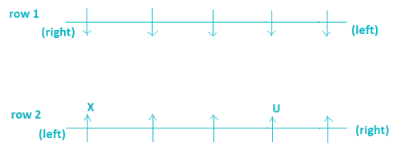

Case II

2) F faces immediate neighbor of X.
(There will be three possible cases)
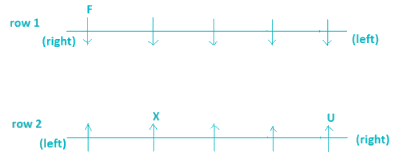
Case II

Case III
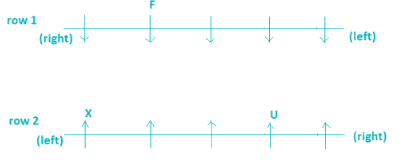
(There will be three possible cases)

Case II

Case III

3) H sits second to the right of F.
(Hence, Case I and III will be eliminated, so we can further proceed with case II)
(Hence, Case I and III will be eliminated, so we can further proceed with case II)
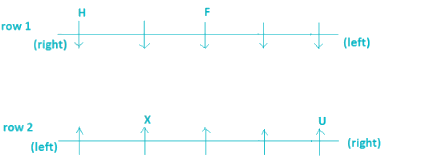
4) Only one person sits between G and I.
(There will be two possible cases)
Case I
(There will be two possible cases)
Case I

Case II
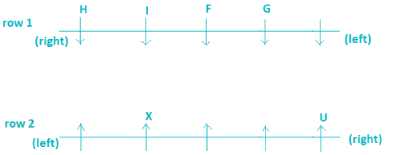
5) V and Y are immediate neighbors.
(There will be four possible cases)
Case I
(There will be four possible cases)
Case I

Case II

Case III
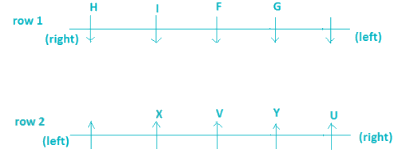
Case IV

6) Y does not face F and G.
(Hence, case II, III and IV will be eliminated, we can further proceed with case I)
(Hence, case II, III and IV will be eliminated, we can further proceed with case I)

Clearly, X sits on the immediate left of V.

|
Explore Courses for Government Jobs exam
|

|
Directions:Study the following information carefully and answer the questions given below:Ten persons are sitting in two parallel rows containing five persons each in such a way that there is an equal distance between adjacent persons. In the first row, F, G, H, I and J are seated and all of them are facing south. In the 2ndrow, U, V, W, X and Y are seated and all of them are facing north. Therefore, in the given seating arrangement, each member seated in a row faces another member of the other row.X sits third to the left of U. F faces immediate neighbor of X. H sits second to the right of F. Only one person sits between G and I. V and Y are immediate neighbors. Y does not face F and G.Q.Which of the following is true regarding V?a)U and W are immediate neighbours of Vb)V sits at one of the extreme ends of the linec)J is an immediate neighbour of the person facing Vd)X sits on the immediate left of Ve)None of theseCorrect answer is option 'D'. Can you explain this answer?
Question Description
Directions:Study the following information carefully and answer the questions given below:Ten persons are sitting in two parallel rows containing five persons each in such a way that there is an equal distance between adjacent persons. In the first row, F, G, H, I and J are seated and all of them are facing south. In the 2ndrow, U, V, W, X and Y are seated and all of them are facing north. Therefore, in the given seating arrangement, each member seated in a row faces another member of the other row.X sits third to the left of U. F faces immediate neighbor of X. H sits second to the right of F. Only one person sits between G and I. V and Y are immediate neighbors. Y does not face F and G.Q.Which of the following is true regarding V?a)U and W are immediate neighbours of Vb)V sits at one of the extreme ends of the linec)J is an immediate neighbour of the person facing Vd)X sits on the immediate left of Ve)None of theseCorrect answer is option 'D'. Can you explain this answer? for Government Jobs 2025 is part of Government Jobs preparation. The Question and answers have been prepared according to the Government Jobs exam syllabus. Information about Directions:Study the following information carefully and answer the questions given below:Ten persons are sitting in two parallel rows containing five persons each in such a way that there is an equal distance between adjacent persons. In the first row, F, G, H, I and J are seated and all of them are facing south. In the 2ndrow, U, V, W, X and Y are seated and all of them are facing north. Therefore, in the given seating arrangement, each member seated in a row faces another member of the other row.X sits third to the left of U. F faces immediate neighbor of X. H sits second to the right of F. Only one person sits between G and I. V and Y are immediate neighbors. Y does not face F and G.Q.Which of the following is true regarding V?a)U and W are immediate neighbours of Vb)V sits at one of the extreme ends of the linec)J is an immediate neighbour of the person facing Vd)X sits on the immediate left of Ve)None of theseCorrect answer is option 'D'. Can you explain this answer? covers all topics & solutions for Government Jobs 2025 Exam. Find important definitions, questions, meanings, examples, exercises and tests below for Directions:Study the following information carefully and answer the questions given below:Ten persons are sitting in two parallel rows containing five persons each in such a way that there is an equal distance between adjacent persons. In the first row, F, G, H, I and J are seated and all of them are facing south. In the 2ndrow, U, V, W, X and Y are seated and all of them are facing north. Therefore, in the given seating arrangement, each member seated in a row faces another member of the other row.X sits third to the left of U. F faces immediate neighbor of X. H sits second to the right of F. Only one person sits between G and I. V and Y are immediate neighbors. Y does not face F and G.Q.Which of the following is true regarding V?a)U and W are immediate neighbours of Vb)V sits at one of the extreme ends of the linec)J is an immediate neighbour of the person facing Vd)X sits on the immediate left of Ve)None of theseCorrect answer is option 'D'. Can you explain this answer?.
Directions:Study the following information carefully and answer the questions given below:Ten persons are sitting in two parallel rows containing five persons each in such a way that there is an equal distance between adjacent persons. In the first row, F, G, H, I and J are seated and all of them are facing south. In the 2ndrow, U, V, W, X and Y are seated and all of them are facing north. Therefore, in the given seating arrangement, each member seated in a row faces another member of the other row.X sits third to the left of U. F faces immediate neighbor of X. H sits second to the right of F. Only one person sits between G and I. V and Y are immediate neighbors. Y does not face F and G.Q.Which of the following is true regarding V?a)U and W are immediate neighbours of Vb)V sits at one of the extreme ends of the linec)J is an immediate neighbour of the person facing Vd)X sits on the immediate left of Ve)None of theseCorrect answer is option 'D'. Can you explain this answer? for Government Jobs 2025 is part of Government Jobs preparation. The Question and answers have been prepared according to the Government Jobs exam syllabus. Information about Directions:Study the following information carefully and answer the questions given below:Ten persons are sitting in two parallel rows containing five persons each in such a way that there is an equal distance between adjacent persons. In the first row, F, G, H, I and J are seated and all of them are facing south. In the 2ndrow, U, V, W, X and Y are seated and all of them are facing north. Therefore, in the given seating arrangement, each member seated in a row faces another member of the other row.X sits third to the left of U. F faces immediate neighbor of X. H sits second to the right of F. Only one person sits between G and I. V and Y are immediate neighbors. Y does not face F and G.Q.Which of the following is true regarding V?a)U and W are immediate neighbours of Vb)V sits at one of the extreme ends of the linec)J is an immediate neighbour of the person facing Vd)X sits on the immediate left of Ve)None of theseCorrect answer is option 'D'. Can you explain this answer? covers all topics & solutions for Government Jobs 2025 Exam. Find important definitions, questions, meanings, examples, exercises and tests below for Directions:Study the following information carefully and answer the questions given below:Ten persons are sitting in two parallel rows containing five persons each in such a way that there is an equal distance between adjacent persons. In the first row, F, G, H, I and J are seated and all of them are facing south. In the 2ndrow, U, V, W, X and Y are seated and all of them are facing north. Therefore, in the given seating arrangement, each member seated in a row faces another member of the other row.X sits third to the left of U. F faces immediate neighbor of X. H sits second to the right of F. Only one person sits between G and I. V and Y are immediate neighbors. Y does not face F and G.Q.Which of the following is true regarding V?a)U and W are immediate neighbours of Vb)V sits at one of the extreme ends of the linec)J is an immediate neighbour of the person facing Vd)X sits on the immediate left of Ve)None of theseCorrect answer is option 'D'. Can you explain this answer?.
Solutions for Directions:Study the following information carefully and answer the questions given below:Ten persons are sitting in two parallel rows containing five persons each in such a way that there is an equal distance between adjacent persons. In the first row, F, G, H, I and J are seated and all of them are facing south. In the 2ndrow, U, V, W, X and Y are seated and all of them are facing north. Therefore, in the given seating arrangement, each member seated in a row faces another member of the other row.X sits third to the left of U. F faces immediate neighbor of X. H sits second to the right of F. Only one person sits between G and I. V and Y are immediate neighbors. Y does not face F and G.Q.Which of the following is true regarding V?a)U and W are immediate neighbours of Vb)V sits at one of the extreme ends of the linec)J is an immediate neighbour of the person facing Vd)X sits on the immediate left of Ve)None of theseCorrect answer is option 'D'. Can you explain this answer? in English & in Hindi are available as part of our courses for Government Jobs.
Download more important topics, notes, lectures and mock test series for Government Jobs Exam by signing up for free.
Here you can find the meaning of Directions:Study the following information carefully and answer the questions given below:Ten persons are sitting in two parallel rows containing five persons each in such a way that there is an equal distance between adjacent persons. In the first row, F, G, H, I and J are seated and all of them are facing south. In the 2ndrow, U, V, W, X and Y are seated and all of them are facing north. Therefore, in the given seating arrangement, each member seated in a row faces another member of the other row.X sits third to the left of U. F faces immediate neighbor of X. H sits second to the right of F. Only one person sits between G and I. V and Y are immediate neighbors. Y does not face F and G.Q.Which of the following is true regarding V?a)U and W are immediate neighbours of Vb)V sits at one of the extreme ends of the linec)J is an immediate neighbour of the person facing Vd)X sits on the immediate left of Ve)None of theseCorrect answer is option 'D'. Can you explain this answer? defined & explained in the simplest way possible. Besides giving the explanation of
Directions:Study the following information carefully and answer the questions given below:Ten persons are sitting in two parallel rows containing five persons each in such a way that there is an equal distance between adjacent persons. In the first row, F, G, H, I and J are seated and all of them are facing south. In the 2ndrow, U, V, W, X and Y are seated and all of them are facing north. Therefore, in the given seating arrangement, each member seated in a row faces another member of the other row.X sits third to the left of U. F faces immediate neighbor of X. H sits second to the right of F. Only one person sits between G and I. V and Y are immediate neighbors. Y does not face F and G.Q.Which of the following is true regarding V?a)U and W are immediate neighbours of Vb)V sits at one of the extreme ends of the linec)J is an immediate neighbour of the person facing Vd)X sits on the immediate left of Ve)None of theseCorrect answer is option 'D'. Can you explain this answer?, a detailed solution for Directions:Study the following information carefully and answer the questions given below:Ten persons are sitting in two parallel rows containing five persons each in such a way that there is an equal distance between adjacent persons. In the first row, F, G, H, I and J are seated and all of them are facing south. In the 2ndrow, U, V, W, X and Y are seated and all of them are facing north. Therefore, in the given seating arrangement, each member seated in a row faces another member of the other row.X sits third to the left of U. F faces immediate neighbor of X. H sits second to the right of F. Only one person sits between G and I. V and Y are immediate neighbors. Y does not face F and G.Q.Which of the following is true regarding V?a)U and W are immediate neighbours of Vb)V sits at one of the extreme ends of the linec)J is an immediate neighbour of the person facing Vd)X sits on the immediate left of Ve)None of theseCorrect answer is option 'D'. Can you explain this answer? has been provided alongside types of Directions:Study the following information carefully and answer the questions given below:Ten persons are sitting in two parallel rows containing five persons each in such a way that there is an equal distance between adjacent persons. In the first row, F, G, H, I and J are seated and all of them are facing south. In the 2ndrow, U, V, W, X and Y are seated and all of them are facing north. Therefore, in the given seating arrangement, each member seated in a row faces another member of the other row.X sits third to the left of U. F faces immediate neighbor of X. H sits second to the right of F. Only one person sits between G and I. V and Y are immediate neighbors. Y does not face F and G.Q.Which of the following is true regarding V?a)U and W are immediate neighbours of Vb)V sits at one of the extreme ends of the linec)J is an immediate neighbour of the person facing Vd)X sits on the immediate left of Ve)None of theseCorrect answer is option 'D'. Can you explain this answer? theory, EduRev gives you an
ample number of questions to practice Directions:Study the following information carefully and answer the questions given below:Ten persons are sitting in two parallel rows containing five persons each in such a way that there is an equal distance between adjacent persons. In the first row, F, G, H, I and J are seated and all of them are facing south. In the 2ndrow, U, V, W, X and Y are seated and all of them are facing north. Therefore, in the given seating arrangement, each member seated in a row faces another member of the other row.X sits third to the left of U. F faces immediate neighbor of X. H sits second to the right of F. Only one person sits between G and I. V and Y are immediate neighbors. Y does not face F and G.Q.Which of the following is true regarding V?a)U and W are immediate neighbours of Vb)V sits at one of the extreme ends of the linec)J is an immediate neighbour of the person facing Vd)X sits on the immediate left of Ve)None of theseCorrect answer is option 'D'. Can you explain this answer? tests, examples and also practice Government Jobs tests.

|
Explore Courses for Government Jobs exam
|

|
Signup for Free!
Signup to see your scores go up within 7 days! Learn & Practice with 1000+ FREE Notes, Videos & Tests.

















